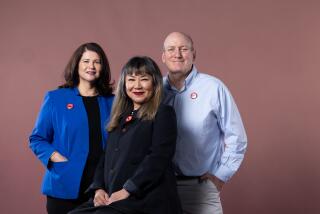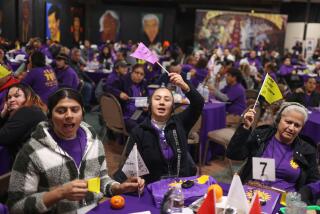AFL-CIO Will Go West Next Winter
- Share via
BAL HARBOUR, Fla. — The sun is setting on one of the American labor movement’s dearest traditions: the AFL-CIO’s annual winter bash along the beachfront here in balmy south Florida.
This week’s gathering marks the end of nearly 60 consecutive years of get-togethers at Miami-area resorts to conduct union--and monkey--business.
For Teamsters from Toledo and steelworkers from Scranton eager to escape the cold, the news isn’t all bad. Next year’s destination is expected to be Los Angeles, a pretty fair tourism mecca in its own right.
Still, the new regime that took charge of the AFL-CIO in October is hoping to emphasize the message that labor’s leadership is in touch with issues crucial to ordinary working people. To that end, the labor federation plans to rotate its yearly winter meetings among cities more symbolic of labor’s struggles than of its frolicking-in-the-sun excesses.
“With the anxieties working families are facing today and the stresses workers face, we thought it would be more appropriate in settings where we could be more a part of the struggle,” said Denise Mitchell, a special assistant to AFL-CIO President John Sweeney.
Los Angeles, Mitchell said, represents the diversity emerging in the work force and low-wage industries that are ripe for unionization. (The early word is that a downtown hotel, possibly the Westin Bonaventure Hotel & Suites, will snare the meeting.)
Even for those enjoying their last stay in Bal Harbour, however, there are serious issues on the agenda of the four-day AFL-CIO gathering that began Monday.
Members of the labor federation’s executive council, its key decision-making body, adopted plans to clear the way for the Sweeney regime to embark on efforts to expand union organizing.
Sweeney, who won his insurgent campaign for the presidency of the AFL-CIO last year on a promise of expanded organizing, has been criticized as getting off to a slow start. But with his new organizing department now established and his own cadre of top assistants in place at the AFL-CIO, Sweeney said the federation will start funding organizing drives soon, perhaps within a month.
One beneficiary could be a long-planned Southland effort known as the Los Angeles Manufacturing Action Project, which would bring together a coalition of four or more unions to organize workers in the Alameda Corridor. Sweeney and other union officials declined to discuss what organizing campaigns are likely to be supported by the AFL-CIO, but several labor leaders have said previously that LAMAP could be the prototype for the multi-union efforts that Sweeney envisions.
Separately, Vice President Al Gore spoke to the AFL-CIO’s executive council and brought the message that President Clinton would veto Republican bills to rein in the Occupational Safety and Health Administration if Congress passes them. Gore also pledged the administration’s support for another issue close to labor’s heart: raising the minimum wage.
In coming days, AFL-CIO’s top leaders will focus on another key Sweeney goal, stepping up grass-roots political organizing.
Union officials from across the country were supportive of Sweeney’s broad plans, but the closer-to-home issue of leaving Bal Harbour after this year remained a matter of debate--most of it good-humored--around the pools and in the corridors.
One supporter of the change, who begged not to be identified, jokingly complained that “there’s a lot of excessive white flesh exposed around the swimming pool.”
But on a more serious note, the official said, a bad image endures of a glamorous resort “where people who represent workers and talk about low wages are having a good time.”
More to Read
Inside the business of entertainment
The Wide Shot brings you news, analysis and insights on everything from streaming wars to production — and what it all means for the future.
You may occasionally receive promotional content from the Los Angeles Times.









